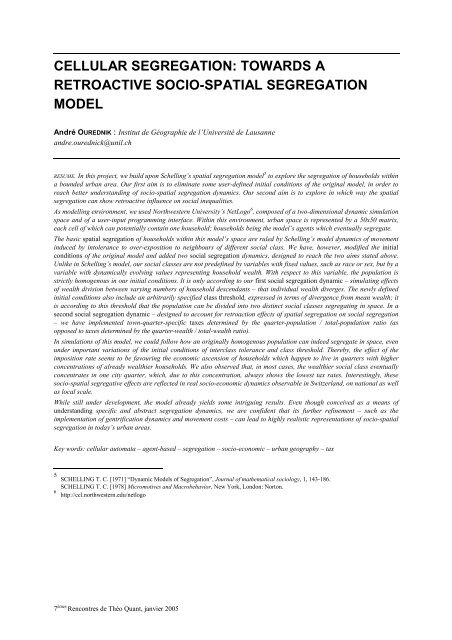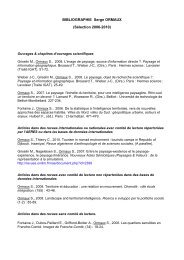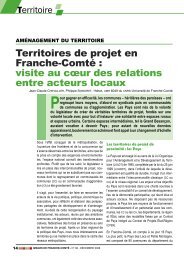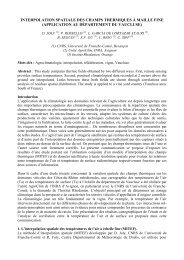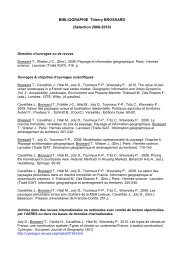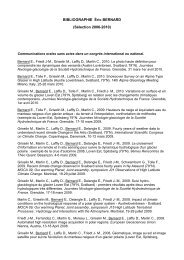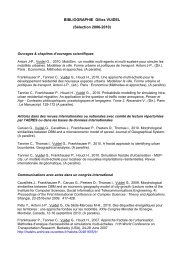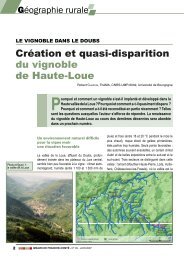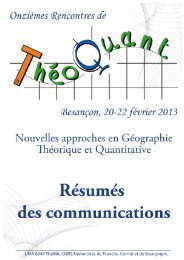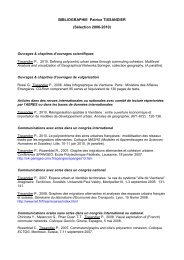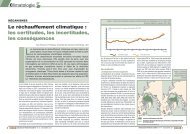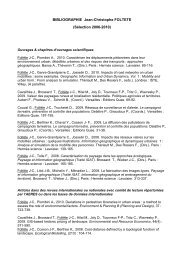Télécharger les résumés - ThéMA - Université de Franche-Comté
Télécharger les résumés - ThéMA - Université de Franche-Comté
Télécharger les résumés - ThéMA - Université de Franche-Comté
You also want an ePaper? Increase the reach of your titles
YUMPU automatically turns print PDFs into web optimized ePapers that Google loves.
CELLULAR SEGREGATION: TOWARDS A<br />
RETROACTIVE SOCIO-SPATIAL SEGREGATION<br />
MODEL<br />
André OUREDNIK : Institut <strong>de</strong> Géographie <strong>de</strong> l’<strong>Université</strong> <strong>de</strong> Lausanne<br />
andre.ourednick@unil.ch<br />
RESUME. In this project, we build upon Schelling’s spatial segregation mo<strong>de</strong>l 5 to explore the segregation of households within<br />
a boun<strong>de</strong>d urban area. Our first aim is to eliminate some user-<strong>de</strong>fined initial conditions of the original mo<strong>de</strong>l, in or<strong>de</strong>r to<br />
reach better un<strong>de</strong>rstanding of socio-spatial segregation dynamics. Our second aim is to explore in which way the spatial<br />
segregation can show retroactive influence on social inequalities.<br />
As mo<strong>de</strong>lling environment, we used Northwestern University’s NetLogo 6 , composed of a two-dimensional dynamic simulation<br />
space and of a user-input programming interface. Within this environment, urban space is represented by a 50x50 matrix,<br />
each cell of which can potentially contain one household; households being the mo<strong>de</strong>l’s agents which eventually segregate.<br />
The basic spatial segregation of households within this mo<strong>de</strong>l’s space are ruled by Schelling’s mo<strong>de</strong>l dynamics of movement<br />
induced by intolerance to over-exposition to neighbours of different social class. We have, however, modified the initial<br />
conditions of the original mo<strong>de</strong>l and ad<strong>de</strong>d two social segregation dynamics, <strong>de</strong>signed to reach the two aims stated above.<br />
Unlike in Schelling’s mo<strong>de</strong>l, our social classes are not pre<strong>de</strong>fined by variab<strong>les</strong> with fixed values, such as race or sex, but by a<br />
variable with dynamically evolving values representing household wealth. With respect to this variable, the population is<br />
strictly homogenous in our initial conditions. It is only according to our first social segregation dynamic – simulating effects<br />
of wealth division between varying numbers of household <strong>de</strong>scendants – that individual wealth diverges. The newly <strong>de</strong>fined<br />
initial conditions also inclu<strong>de</strong> an arbitrarily specified class threshold, expressed in terms of divergence from mean wealth; it<br />
is according to this threshold that the population can be divi<strong>de</strong>d into two distinct social classes segregating in space. In a<br />
second social segregation dynamic – <strong>de</strong>signed to account for retroaction effects of spatial segregation on social segregation<br />
– we have implemented town-quarter-specific taxes <strong>de</strong>termined by the quarter-population / total-population ratio (as<br />
opposed to taxes <strong>de</strong>termined by the quarter-wealth / total-wealth ratio).<br />
In simulations of this mo<strong>de</strong>l, we could follow how an originally homogenous population can in<strong>de</strong>ed segregate in space, even<br />
un<strong>de</strong>r important variations of the initial conditions of interclass tolerance and class threshold. Thereby, the effect of the<br />
imposition rate seems to be favouring the economic ascension of households which happen to live in quarters with higher<br />
concentrations of already wealthier households. We also observed that, in most cases, the wealthier social class eventually<br />
concentrates in one city quarter, which, due to this concentration, always shows the lowest tax rates. Interestingly, these<br />
socio-spatial segregative effects are reflected in real socio-economic dynamics observable in Switzerland, on national as well<br />
as local scale.<br />
While still un<strong>de</strong>r <strong>de</strong>velopment, the mo<strong>de</strong>l already yields some intriguing results. Even though conceived as a means of<br />
un<strong>de</strong>rstanding specific and abstract segregation dynamics, we are confi<strong>de</strong>nt that its further refinement – such as the<br />
implementation of gentrification dynamics and movement costs – can lead to highly realistic representations of socio-spatial<br />
segregation in today’s urban areas.<br />
Key words: cellular automata – agent-based – segregation – socio-economic – urban geography – tax<br />
5 SCHELLING T. C. [1971] “Dynamic Mo<strong>de</strong>ls of Segregation”, Journal of mathematical sociology, 1, 143-186.<br />
SCHELLING T. C. [1978] Micromotives and Macrobehavior, New York, London: Norton.<br />
6 http://ccl.northwestern.edu/netlogo<br />
7 èmes Rencontres <strong>de</strong> Théo Quant, janvier 2005


